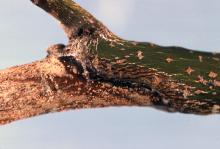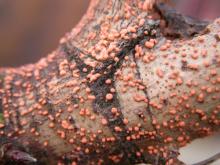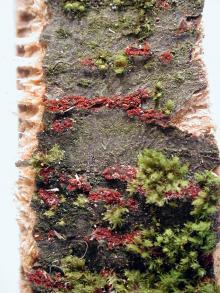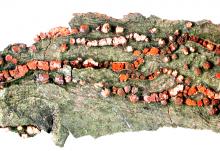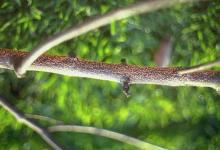See:
Apple (Malus spp.) - Nectria Twig Blight (Coral Spot)
Cause Nectria cinnabarina (asexual: Tubercularia vulgaris) and Neonectria ditissima (asexual: N. galligena), fungi that invade trees through wounds and injuries including winter injury, drought damage, sunscald, leaf scars, cracks in the twig axil, or senescent low branches. Spores are splash dispersed from fruiting bodies that exude spores in rainy weather or during irrigation.
Symptoms N. cinnabarina-girdling cankers form on twigs, limbs, and sometimes trunks; then affected parts die. Cankers appear as slightly sunken areas generally associated with wounds. Cankers are not obvious until striking, orange-red, fungus-fruiting structures (perithecia) develop in large numbers in the cankered area.
N. galligena-Symptoms are similar to those for N. cinnabarina. However, if the tree or branch is not girdled, an elongate or elliptical canker forms year after year. Branches can become quite swollen and weakened and may break at this point in wind or ice storms.
Cultural control
- Remove and destroy affected twigs and limbs. Do not leave them on the ground between rows; carry them out to a burn pile or bury them completely into the soil.
- Prune during dry weather near the end of the dormant period.
- Avoid wounds.
- Avoid leaving pruning stubs when removing rootstock top growth. Make a clean cut with a sharp tool, which will heal promptly.
- Maintain tree vigor through proper fertilizing and watering.
Chemical control Apply fungicide after pruning but before a rain or irrigation to protect wounds against infection. No specific registrations are for this purpose. Many fungicides recommended for anthracnose control also help protect trees from nectria canker.
Reference Gleason, M. and Hartman, J. Maple diseases. In: Jones, R.K. and Benson, D.M. (eds.) 2001. Diseases of Woody Ornamentals and Trees in Nurseries. St. Paul, MN: APS Press.


